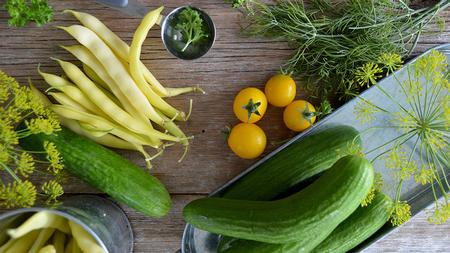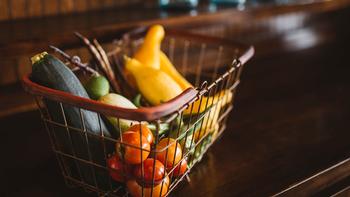News from the Edible Demo Garden
July 2021: Summer Harvesting Tips

General Harvesting Rules
Do not fall into the ‘bigger is better’ trap.
Peak quality often happens before a vegetable is fully mature.
Harvest in the early morning hours.
Plants regain moisture overnight. In addition, the starches formed during the day may be converted to sugars in the evening. You will get crisper, juicier, and sweeter vegetables in the morning.
Be gentle when harvesting.
If the vegetable is not easily picked, then use a knife, scissors, or pruner. Be careful not to damage the leaves and stems of the plant.
Pick frequently to prolong the harvest.
Keep in mind that a plant’s goal is to reproduce. If a plant’s fruit is allowed to fully mature, there is no need for the plant to continue flowering. Fruit production will slow or even cease.
Harvesting Tips for Specific Summer Vegetables

Cucumbers: Pick slicing types when six to nine inches long and pickling types between two to six inches. They should be bright green and firm.
Eggplant: Harvest when about four to six inches in diameter. Fruit should be shiny and uniform in color. When pressed slightly with a thumbnail, the indentation remains.
Peppers (Sweet): Pick when they are green and as soon as they stop enlarging. They can mature on the vine to red, yellow, or purple but the ripening process may keep the plant from setting new fruit. If you want abundance, pick them green.
Squash (Summer): The rule of thumb with summer squash is ‘the smaller the squash, the better it tastes.’ Pick every one -three day(s) and don’t let them mature on the vine. Pick when crookneck or straight varieties are a maximum of one and a half -two inches in diameter, zucchini is seven-eight inches long, and scallop types are three- four inches in diameter. But if you want your squash to be extra tender, harvest them before they reach the sizes listed above.
Squash (Winter): In contrast to summer squash, winter types (pumpkins, acorn, butternut, Delicata) must fully mature on the vine for that deep sweet flavor. It is better to leave them too long on the vine than not long enough. Wait for the squash to reach maximum size, the shell is so hard that it cannot be punctured with your thumbnail, and the color is dull and uniform. The final clue is that the green color of the stem changes and develops brown woody stripes. Nature tells you when the fruit is ready to separate from the vine.
Tomatoes: Tomatoes are complicated. You have two choices:
Fully Ripen on the Vine: A ripe tomato should feel heavy. It should also give slightly to the touch, neither too firm nor too soft, but just a little tender. For solid color tomatoes, the color should be even all over. Check the color on the bottom of a tomato, the deeper the color the riper it is. Some tomatoes tend to have green shoulders like Cherokee Purple. If the rest of the tomato appears fully ripe, then it is ripe for the picking.
Pick With First Traces of Color and Ripen Indoors: The central question with this method is whether, as a few studies have indicated, the vine shuts down the transfer of nutrients and flavor when the tomato begins ripening showing the first traces of color. After side-by-side comparisons, some people believe the flavor of a kitchen-ripened tomato is no different from a vine-ripened one. There are many reasons why you might want to use this method: to reduce the risk of cracking and blossom end rot, to deny the birds and squirrels a fully ripened tomato, and to avoid damage from a heat wave, which negatively effects ripening and causes sun scald. Also, too many tomatoes ripening at once can slow down further fruit production.
If you want to try this method, pick your tomatoes when they start to develop streaks of color down at the blossom end. Store them away from sunlight in a shallow dish or even on a baking rack so the air can circulate under them. They will ripen best at temperatures between 65°-70°.
So, when you take that morning trip to your garden and you have gently removed an armload of summer squash and ripe (or not quite ripe) tomatoes to bring to your kitchen, enjoy the sublime taste of your own hard work. There is nothing like it!
